Menu
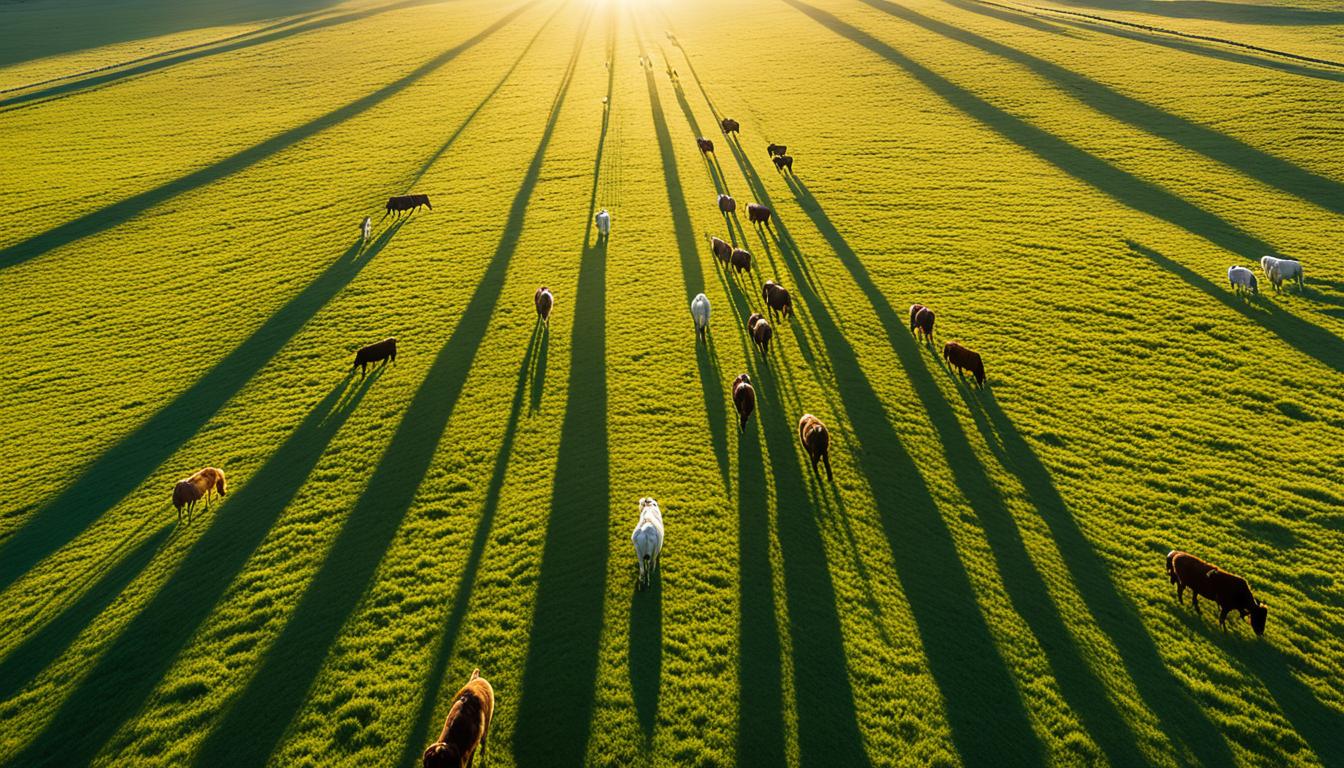
Did you know, livestock production is responsible for about 12% of the world’s greenhouse gas emissions? This puts Argentina in the spotlight because it’s among the top beef-producing countries. As more people look for sustainable farming, Argentina is working hard to balance tradition and new ways for a greener livestock sector.
In Argentina, looking after livestock has a long history that’s now combined with modern techniques. The country is making big steps, like getting carbon-neutral certifications and using silvopastoral systems. These systems, which mix trees with grazing, help both the environment and the cattle industry.
Argentina is all about farming in ways that don’t harm the planet. It’s using cool methods to lower methane, like adding red seaweed to the feed. This can decrease emissions a lot, proving a focus on doing well for both productivity and the Earth. These steps are more than ideas; they’re part of a plan to run farms better and get certifications for cutting emissions.
For Argentina, moving towards green livestock farming means keeping its farming history strong while leading with eco-friendly ideas. This combo helps sell its products in bigger markets, especially Europe and America, where people look for high sustainability. By staying competitive, Argentina’s livestock is meeting the world’s green standards.
Argentina’s livestock industry is famous worldwide for its beef. It is closely tied to the country’s identity. The sector has a long history, starting from historical livestock farming Argentina to facing new challenges today.
In colonial times, European settlers brought cattle to Argentina’s open grasslands, called the Pampas. This practice grew throughout the centuries.
Now, areas like Buenos Aires and Córdoba are vital for raising cattle. They hold more than half of the country’s cow population.
There are about 52 million cows in Argentina, mainly on 130,800 farms. In 2020, they produced 3.17 million tonnes of meat.
Around 900,700 tonnes were exported. Most of this went to China. By early this year, China still bought the most, followed by Israel and Chile.
But, raising cattle can harm the environment. Greenpeace says it’s a top cause of forest loss in some areas. In 2019, over 80,938 hectares were cut down. This caused more than 20 million tonnes of CO2 to be released.
Adopting green aims is key. These projects push for eco-friendly ways to produce meat.
They focus on cutting down pollution. They also work on keeping the soil and water healthy.
Cutting CO2 from cattle farming is getting a big push. Experts say grasslands can soak up more CO2 than we thought. This could balance out the CO2 cows produce.
European buyers might not understand how green Argentina’s beef really is. This misbelief can lead to more concern about CO2 from raising cows.
Some programmes are helping make meat-raising greener. They want farmers to find ways to lower the industry’s CO2 output.
This aims to make meat production better for the planet. They think these changes can happen without big costs for farmers.
| Statistic | Data |
|---|---|
| Total Cattle | 52 million head |
| Dedicated Farms | 130,800 |
| Meat Production (2020) | 3.17 million tonnes |
| Exports to China (2020) | 900,700 tonnes |
| First Quarter Export Destinations | China, Israel, Chile |
| Deforestation (2019) | 80,938 hectares |
| CO2 Emissions | 20 million tonnes of CO2 equivalent |
The future of Argentina’s meat industry mixes old ways with new ideas. This includes thinking about the environment a lot more.
In Argentina, cattle farming is vital for the economy, especially in the Pampas region. This area is known for being really good at managing cattle. They focus on nutrition, keeping things clean, and using the best genetic lines. It all helps make a lot of beef.
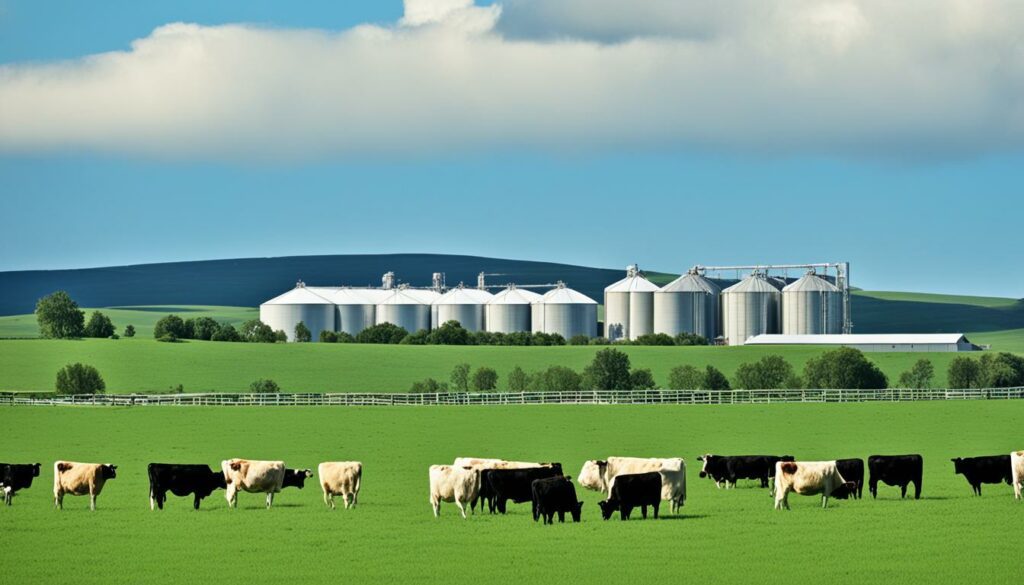
Buenos Aires, Córdoba, and Santa Fe are key areas for raising cattle. They are at the core of Argentina’s agricultural activities. More than half of the country’s cows are found here. This concentration shows how important these provinces are to Argentina’s cattle farming.
There are about 52 million cows in Argentina. With this many cows, Argentina can meet its own meat needs and still export a lot. For example, in 2020 they produced over 3.17 million tonnes of meat. Of that, 900,700 tonnes went to China. This shows Argentina is big in the global beef market.
| Region | Cattle Population |
|---|---|
| Buenos Aires | Approx. 26 million |
| Córdoba | Approx. 10 million |
| Santa Fe | Approx. 6 million |
About 70% of the meat made in Argentina is used within the country. This shows how important cattle farming is nationally. There are about 130,800 farms solely focused on raising cattle. Even though cows produce about a fifth of Argentina’s greenhouse gases, the country’s pastures are really good at storing carbon. They have enough potential to absorb carbon as much as their annual output for 74 years.
Argentina leads in ranching, blending old ways with new. It owes its success to traditional methods and the skilled gauchos. These ways have been refined over many years but still evolve to match today’s needs.
In Argentina, cattle graze on natural pastures. This is different from the mass-farming that harms our planet. By being fed with what nature provides, these cattle leave a smaller environmental mark.
Argentina isn’t stuck in the past, though. It has adopted new techniques for better farming. These include smart software for feeding and ways to cut harmful greenhouse gases.
Mixing the old with the new boosts Argentina’s ranching future. It honours tradition while advancing towards a more effective and sustainable path. As a result, Argentina shines as a leader in smart, ethical cattle farming.
| Aspect | Traditional Methods | Modern Innovations |
|---|---|---|
| Feeding Practices | Pasture-based, no genetically modified grains | Optimised diet formulations using feeding software |
| Environmental Impact | Smaller footprint compared to factory farms | Reduction in nitrous oxide emissions |
| Management Techniques | Led by gauchos, hands-on herding | Data-driven approaches to improve efficiency |
In Argentina, sustainable farming practices are crucial for both the economy and the environment. The sector is moving towards these methods to meet global standards and help the planet. It’s key to aim for a carbon-neutral livestock certification and bring in silvopastoral systems.
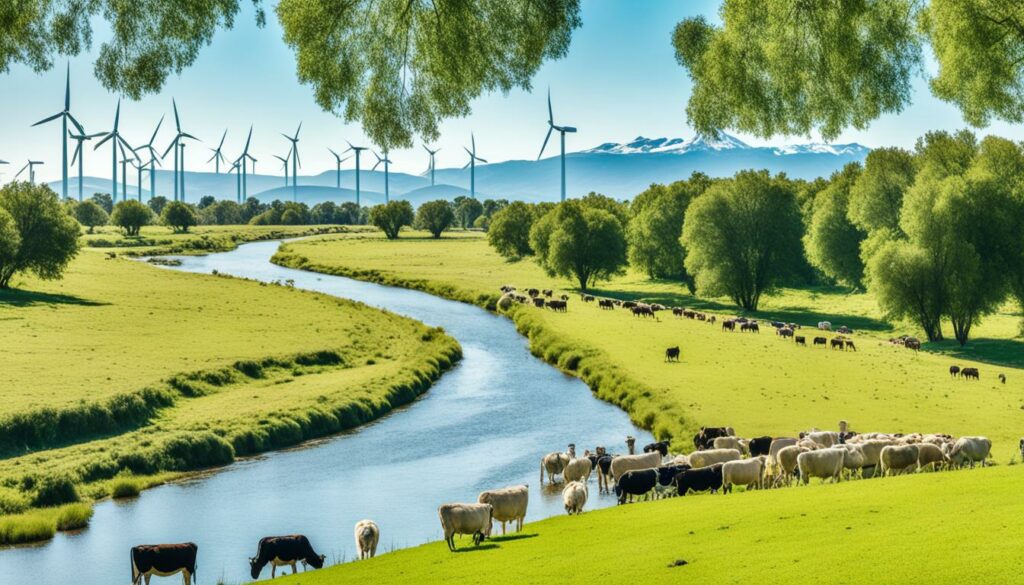
In Argentina, getting a carbon-neutral livestock certification means serious checks by outsiders. They look at how plants and soil help capture carbon. This is vital because 20.7% of Argentina’s greenhouse gases come from livestock. This new approach includes nature’s help in reducing emissions. It makes the livestock sector more eco-friendly and attractive to global buyers.
Silvopastoral systems play a big role in sustainable farming practices in Argentina. They mix tree farming with animal grazing, creating a rich environment for plants and animals. This boosts nature diversity and helps cut down on harmful methane. Using silvopastoral systems in Argentina’s vast meadows can reduce climate impact and support the goal of zero emissions from livestock.
These efforts also match up with global agreements, like the one made in Glasgow on forests and land use. With over 52 million cattle on 130,800 farms, the livestock business is crucial for Argentina’s growth and green goals. Improving how we manage the land can make a big difference. It can make the livestock sector a more welcome part of the local and worldwide community.
In Argentina, caring for animals is a key part of farming. Farmers focus on what animals eat and how happy and healthy they are. By making sure animals eat well and are looked after, they perform better and lead happier lives. This helps farmers economically because healthy animals are more productive.
Argentina works hard to feed its animals in smart ways. It uses special feeds, like red seaweed, to help reduce harmful gas from cows. These feeding methods help the animals use energy better. As a result, they grow faster and stay healthy.
Improving how much animals produce connects to better food and happier living spaces. In Argentina, animals get enough room to move, good homes, and different foods. This care makes them grow quicker and make more milk. Even though good care costs more, it’s balanced out by cheaper land and workers.
Fitting animal care to global standards also helps reach more customers. People worldwide like products made with care for animals. This not only looks after the animals but also helps Argentina’s farming stay strong over time.
Since 1998, good pasture management has been key in Argentina, especially in the Flooding Pampa area. This region gets about 900 mm of rain each year. They aim for a stable stocking rate, which has led to 80% more meat than the average. They’ve achieved this by carefully using grazing methods and regenerating pastures.
Using the right grazing techniques is vital for keeping livestock healthy and productive. Rotational grazing is a top method. It helps native grasses grow well. This keeps the pasture healthy and balanced. I’ve seen how easy access to water can make a big difference. When animals can drink easily, they graze better. This shows in their health and the land’s condition.
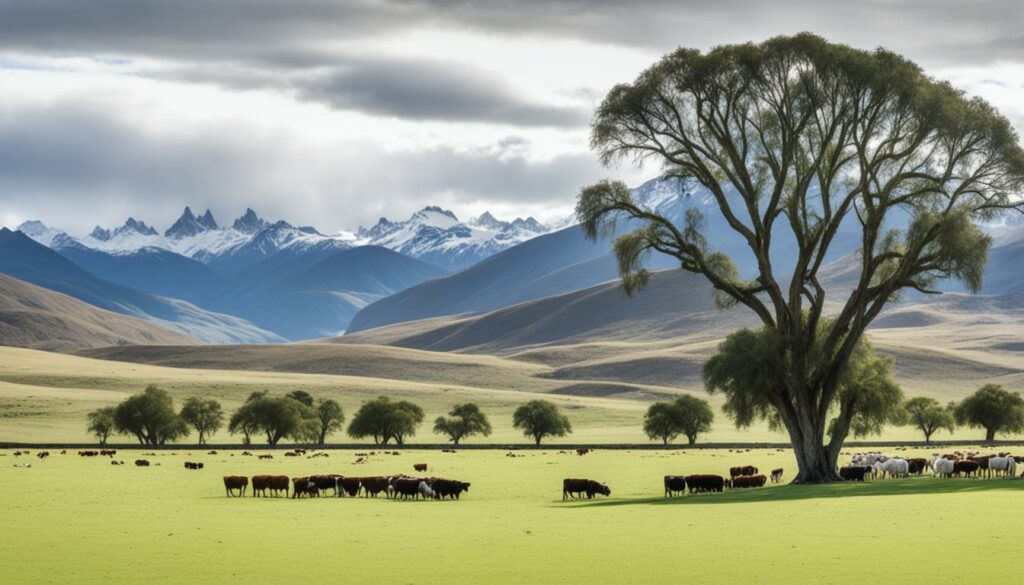
Oddly, in this area, they don’t like permanent fences much. They start with portable ones to find the best grazing system. Having water where it’s needed, especially when it’s hot, is also key. They use big tanks and make sure they’re set up right for the animals’ health. This prevents issues like foot rot.
Keeping the soil healthy through good pasture regrowth is essential in Argentina. After 15 years of hard work, experts found the best grass types to use. Overgrazing is a big problem. It’s usually due to not managing time well, not having too many animals. They suggest going from traditional to more intense grazing to improve.
Grass is vital for both the land and the animals it feeds. It’s crucial for managing livestock well in Argentina. By making sure the grass is healthy, they also help the soil and fight climate change through good soil practices. This way, they support a sustainable future for their farms and the planet.
| Year Implemented | Meat Production Increase | Average Rainfall (mm) |
|---|---|---|
| 1998 | 80% | 900 mm/year |
Keeping livestock healthy is key for farmers in Argentina. The livestock sector here helps support the lives and food of about 1.3 billion people around the world. This makes Argentina carefully manage health to protect its valuable livestock.
Livestock in Argentina can get sick with various health problems that lower their productivity. They often face issues such as parasitic infections, breathing problems, and lack of proper nutrition. These problems can get worse when the animals face changing weather and stress.
| Region | Common Health Issues |
|---|---|
| Pampeana | Respiratory infections, parasitic infestations |
| North West | Nutritional deficiencies, heat stress |
| North East | Parasitic infestations, humidity-related diseases |
| Patagonia | Cold stress, mineral deficiencies |
Argentina’s livestock sector focuses on preventing these health problems. They rely on essential vaccination programmes for diseases like foot-and-mouth and respiratory viruses. It’s crucial to keep an eye on the livestock’s health to stop diseases from spreading.
They also work hard to lessen the impact of stress from the environment. This means making sure livestock has good shelter during bad weather, managing the places they graze, and feeding them well to support their immune systems. These efforts help ensure the animals are healthy, which is vital for the industry to remain strong and successful.
Argentina is leading the way in combining modern tech with eco-friendly farming. It’s making great use of feeding software and smart ways to handle harmful nitrous oxide gases. These practices not only make farming greener but also help increase farm output. This balanced approach is vital for the farms of the future.

Argentina is at the forefront of farm tech with its use of feeding software. This software plans diets to fit each animal’s needs. It does this while aiming to reduce food waste and cut down on harmful gases. Using high-tech tools like this shows Argentina’s dedication to smart farming.
Reducing nitrous oxide is a key challenge Argentina’s farmers are meeting head on. This gas is a big concern because it traps heat in our atmosphere. With the help of high-tech feeding methods and even genetic research, Argentina is stepping up. These efforts go a long way in making farming more eco-friendly.
Overall, Argentina’s work in advanced farming is very important. By focusing on smarter ways to feed animals and cutting down gases, they’re showing what the future of farming could look like. It’s all about sustainable growth in agriculture.
Argentina’s livestock sector is vital, making up 20.7% of the nation’s greenhouse gases. These come mostly from cow digestion. Yet, the industry is changing. It’s moving towards sustainable and competitive beef production. This shift focuses on making methods better for the planet and aiming to be the best in export markets.
Argentina is now aiming for carbon-neutral beef. By early 2024, beef from Argentina might carry a special label showing it’s kind to the environment. This move aims to boost Argentina’s image as a top eco-friendly beef maker. The country is working hard on reducing emissions from cows. It’s also focusing on how the land can store carbon to balance out these emissions.
Argentina is looking to grow its beef exports. Major markets like China are important. In 2020, the country sent around 900,700 tonnes of meat overseas. Most of this went to China. To keep up with demand, Argentina is using new farming methods. These methods help improve its export power, making its beef even more attractive abroad.
Younger buyers in China are interested in eco-friendly and safe products. This pushes Argentina to be careful about where its beef comes from and how it’s made. Social and environmental responsibility are key for the country’s beef industry.
Argentina is blending old and new ways in its beef production. By being careful with its impact on the planet, it looks to do well in the global beef market. The future sees Argentina playing a big role in the beef world, in a way that’s friendly to both people and the earth.
In Argentina, livestock breeding mixes traditional ways with new genetic ideas. It aims to boost productivity, build resilience, and care for the environment. The country benefits greatly, with its vast cattle farming, which includes 52 million cattle on over 130,800 farms.
Key in Argentina’s method is selective breeding for certain characteristics. They look at growth, having offspring, and how well animals fit their environment. By choosing animals with the right growth rates and sizes, farmers make their work more efficient and earn more. They’re also working to make cattle need less food, which helps the planet.
Genetic techniques offer exciting chances in Argentina’s livestock sector. For example, through genomic selection, they can find special genetic markers. These markers predict good traits in the cattle, like growth or being able to fight diseases. This boosts a sustainable way of making meat. Also, by studying which Zebu cows make the best meat, Argentina’s beef gets even better.
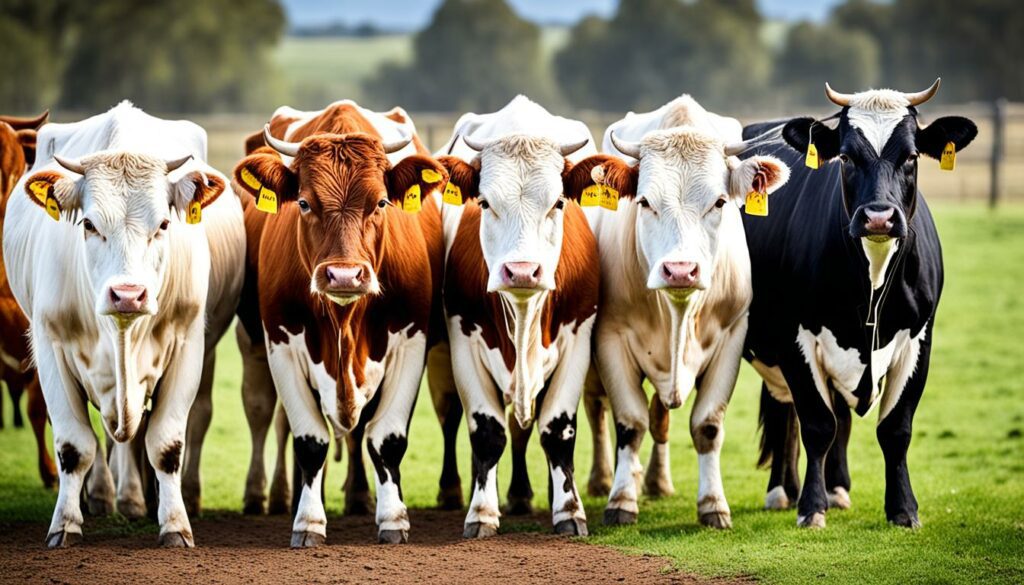
| Statistic | Data | t
|---|---|
| Total Cattle Population | 52 Million | t
| Farms Dedicated to Cattle Production | 130,800 | t
| Meat Production in 2020 | 3.17 Million Tonnes | t
| Domestic Meat Consumption | 70% | t
| Exported Meat in 2020 | 900,700 Tonnes | t
| Export Main Market | China | t
These points show how selective breeding and genetic advances keep Argentina strong in beef markets. They aim to boost production and look after the earth. Doing so helps the nation be both successful and responsible.
Methane emissions from livestock are a big worry in Argentina. The country’s farming sector contributes a lot to the economy. Livestock, making up a large part of farming, also adds to the issue with 42% of farming’s economic impact.
There are two main causes of methane from livestock: their stomachs and their waste. In Argentina, the biggest methane source is from animals’ stomachs at 66.78%. Then comes nitrous oxide from the ground used for animal care at 21.24%. Also, nitrous oxide from animal manure fields is at 10.39%.
Handling animal waste is a small part but key, making up 1.40% of farming’s gas emissions. Cows lead the way in methane from waste, making up 85.48%. Pigs add 4.10%, horses 4.02%, sheep 2.93%, and poultry 1.78%.
Many ways are being looked at to lower methane. First, better ways to manage manure can help a lot. Next, adding things to animals’ food, like red seaweed, could cut methane by 26% to 98%. Gene editing to change how their stomachs work is also a hopeful area. This could lower methane without hurting the animals or how much they produce.
Farm software that improves feeding can help too. Also, there are certifications, like being carbon-neutral, to encourage farmers to use these ways. These steps can bring down the impact livestock have on the environment.
| Emission Source | Contribution (%) |
|---|---|
| Enteric Fermentation | 66.78 |
| Direct Nitrous Oxide Emissions from Soils | 21.24 |
| Indirect Nitrous Oxide Emissions from Soils | 10.39 |
| Manure Management | 1.40 |
Dealing with methane from livestock in Argentina needs many steps. By using new tech and methods, the industry can drop its impact. This change is vital for the environment, without losing out on farming or the economy.
In tackling the impact of livestock on the environment, more focus is now on feed additives. The addition of these special feed ingredients can cut down the amount of methane animals produce. For example, adding red seaweed to their diet can reduce methane by up to 98%. Using such additives not only helps the planet but also boosts farm productivity. This benefits both the environment and the farming industry.
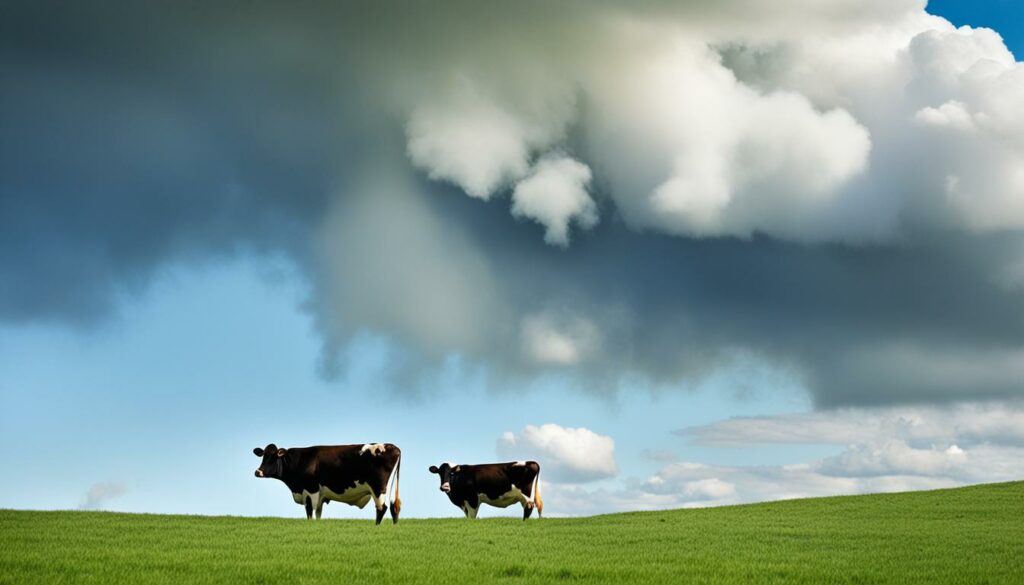
Different feed additives for livestock offer a range of benefits. These include items like red seaweed. Such components are great because they not only reduce methane but enhance the animals’ use of food energy. This means they grow better or produce more milk. The wide variety of additives available shows they can suit many farming situations.
Feed additives show varying effectiveness, usually depending on what they’re made of and how they’re used. For instance, red seaweed can cut methane between 26% and 98%. By doing this, they help animals use their energy more efficiently, boosting productivity. With livestock farming being a big part of global emissions, these additives are important for cutting greenhouse gases. It’s vital that we keep testing them in real farm conditions to make sure they work well and can be used widely.
| Additive Type | Composition | Emissions Reduction (%) | Productivity Benefits |
|---|---|---|---|
| Red Seaweed | Natural Marine Algae | 26% – 98% | Enhanced Growth, Better Milk Production |
| Essential Oils | Plant Extracts | 15% – 20% | Improved Feed Efficiency |
| Probiotics | Beneficial Microorganisms | 10% – 12% | Enhanced Digestion |
| Fatty Acids | Specific Fats | 8% – 10% | Better Nutrient Absorption |
The impact of livestock on climate change has become a big worry, particularly in places like Argentina. The livestock industry makes up about 12% of all greenhouse gas emissions worldwide. A big chunk of this comes from activities like raising cattle for meat, which is the most polluting part of farming.
In Argentina, the livestock industry is linked to over a fifth of the country’s total greenhouse gases. This is mostly due to how cows digest food. In some areas, like sub-Saharan Africa, cows make more gas because they’re not as well cared for as those in North America and Europe. There are new ideas, like changing cows’ genes and feeding them better, to help reduce these harmful emissions.
However, there’s hope in the farming practice known as carbon sequestration grazing. In Argentina, this method effectively captures more carbon than the sector emits by combining grazing with trees. Experts say Argentina’s pastures trap carbon in ways we don’t fully understand yet. By using these techniques, farming could become part of the solution to climate change.
| Statistic | Value |
|---|---|
| Global contribution of livestock to greenhouse gas emissions | 12% |
| Percentage of agriculture’s emissions from livestock | 67% |
| Emissions reduction from feed additives (red seaweed) | 26%-98% |
| Contribution of Argentina’s livestock sector to national emissions | 20.7% |
| Carbon storage potential of Argentina’s grasslands | Equivalent to 74 years of emissions |
Livestock management in Argentina aims to lessen the impact on the environment. It also aims to increase economic efficiency. The demand for meat globally is growing. This is due to more people and better living standards. So, Argentina is improving its cattle farming ways.
A special approach is the silvopastoral system. It combines tree planting with grazing areas. This not only supports different plant and animal life. It also helps soak up carbon and cuts down on harmful methane gas. Adding red seaweed to the animals’ diet could reduce this methane by 26% to 98%. This is a big step towards eco-friendly beef.
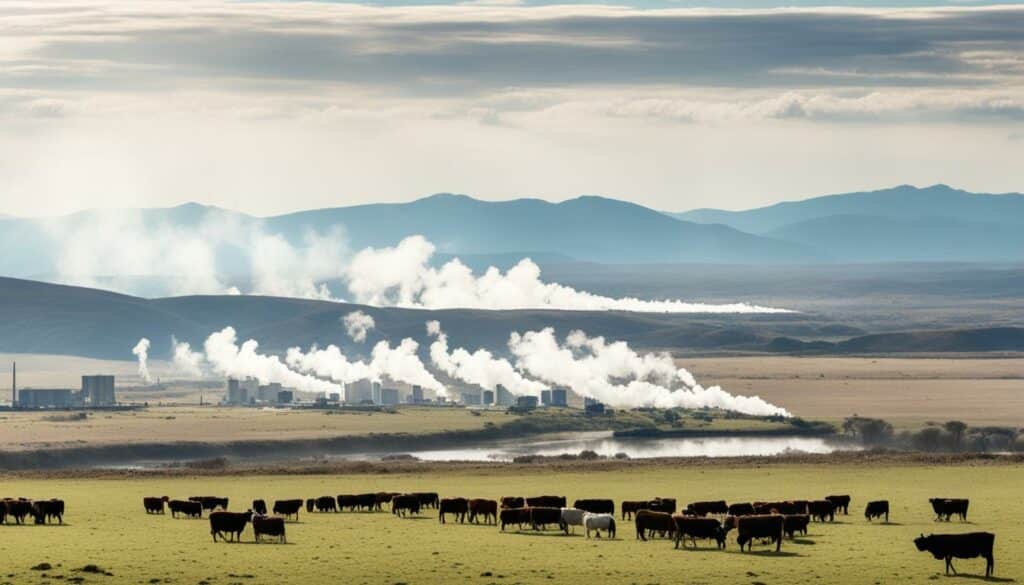
Argentina’s new programme certifies meat as carbon-neutral. This comes from working with experts and businesses. It confirms that their farms remove as much carbon as they produce. The European Commission also supports this, urging others to do the same.
Here’s a table showing the types of animals in Argentina and their emissions:
| Livestock Type | Population (millions) | CH4 Emissions (Gg) | Emission Percentage |
|---|---|---|---|
| Non-Dairy Cattle | 47 | 47 | 82% |
| Dairy Cattle | 2 | – | 3% |
| Pigs | 0.24 | – | 4.1% |
| Horses | 1.5 | – | 4.02% |
| Sheep | 13.5 | – | 2.93% |
| Poultry | – | – | 1.78% |
The table shows that cattle, especially non-dairy, produce the most methane. They are responsible for 82% of the emissions. To reduce this, Argentina is focusing on new technologies and better waste handling.
Carbon-neutral meat might cost more for consumers. But, this is part of a move towards eco-friendlier living. Thanks to these changes, Argentine livestock works towards a better balance between money-making and taking care of the Earth.
Livestock management in Argentina faces big hurdles and chances. A top challenge is the high level of greenhouse gases from rearing animals. These gases make up a big portion of Argentina’s total pollution. Also, the cutting down of trees in the north causes a lot of problems.
It led to large amounts of harmful emissions last year. Yet, there are chances to make things better. People are looking into how much carbon gets kept by trees and grasslands. Some think these areas might store more carbon than we thought. This means they can help balance out the gas emissions.
There’s also talk about feeding cows differently to reduce their impact on the environment. For example, feeding cows grass instead of grain could be better. This helps the soil store more carbon, which is good for the planet.
Looking at the livestock industry, it’s key for the economy but faces challenges. It’s a significant part of Argentina, with millions of cattle and many farms. In 2020, it produced and sold a lot of meat.
China bought most of this meat. Even with problems like high inflation and port issues, the sector is important. Efforts like the IFACC initiative’s funding show a push for sustainable practices.
Issues like pollution and deforestation need tackling fast. People are discussing how to better measure the carbon stored in nature. There’s a belief that the grasslands here can do a lot to reduce our emissions.
The way we feed cows might also make a difference. Feeding them grass could lower the harmful gases they produce. This is because it helps the ground soak up more carbon from the air.
The livestock industry plays a big role in Argentina’s economy and faces issues. It holds a significant place in the country, with many cattle and farms. In 2020, it made and sold a huge amount of meat.
China bought most of this meat. Even with problems like high inflation and port issues, the sector is important. Efforts like the IFACC initiative’s funding show a push for sustainable practices.
The livestock sector impacts Argentina’s economy and environment. Yet, there’s a chance to balance these impacts. By using sustainable ways of farming and better handling manure, Argentina looks towards a green future.
Livestock management in Argentina relies on both old and new methods to last for the long term. It includes careful grazing, keeping animals healthy, and skillful breeding.
Argentina’s livestock sector began with simple farming but now it uses modern methods. This change has made it a big part of worldwide beef production.
In Argentina, the Pampas region, especially Buenos Aires, Córdoba, and Santa Fe, is known for cattle farming. These places use advanced methods and help greatly in the country’s meat making.
Argentina is blending old and new farming techniques, such as better feeding and environmental care. It aims to reduce damage to the environment, like cutting nitrous oxide.
In Argentina, carbon-neutral farming is checked carefully by outside experts. It involves saving carbon in trees and the soil to balance out bad gases like methane.
Nutritional care in Argentina uses advanced food additives and the right diets. New items like red seaweed help make less methane and improve animals and milk making.
In Argentina, good grazing and looking after pastures well are very important. This keeps the soil healthy and helps keep the farms eco-friendly by trapping carbon.
Animals in Argentina can catch diseases and get stressed from the environment. To prevent this, there are vaccines, regular health checks, and ways to deal with stress.
In Argentina, using the best software and environmental approaches makes farming better. It means making more without hurting the environment too much.
Argentina is making beef in ways that don’t harm the earth much. This includes capturing carbon, grazing smarter, and mixing trees with pastures.
Breeding and the latest genetics help make livestock stronger and kinder to the planet. Argentina uses these methods to pick the best animals for farming.
Methane mostly comes from animals’ digestion and managing their waste. Argentina deals with this by better waste handling, using special food and changing animals’ stomach germs.
In Argentina, they feed animals things like red seaweed to lower methane a lot. The success depends on how these additives are made and given to the animals.
Farming animals in Argentina makes a lot of the planet’s bad gases, mainly methane. But they also do good by trapping carbon when animals graze well. This helps make cattle farming less harmful to the planet.
Big challenges are harm to the environment, from cutting down trees to making bad gases. Argentina is working hard to farm in ways that don’t damage the world while still making money.